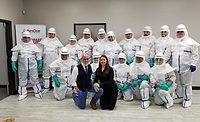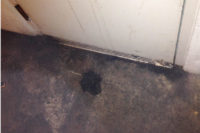Fighting Mold and Bacteria Damage
The microbial cleaning and remediation process may require a multidisciplinary approach

Photos: Getty Images
Mold growth in a building can severely affect its indoor air quality and overall functionality. This can adversely impact the building's materials, assemblies, systems, and contents and pose risks to its occupants' health and well-being. It is, therefore, crucial to address mold growth promptly to mitigate potential exposure and ensure the longevity of the building.
The microbial cleaning and remediation process may require a multidisciplinary approach involving professionals from several fields (e.g., Indoor Environmental Professional (IEP), asbestos, and lead consultants. The IICRC, RIA, and ACAC, among other organizations, train restorers on cleaning and restoring the structure, assemblies, systems, and contents while protecting workers and occupants.
The remediation can be broadly divided into two parts:
First, the control and stabilization procedures, implemented to prevent further contamination and the spread of mold.
Second, the cleaning and remediation procedures, which are carried out to eliminate the suspected or known microbial environment and restore the affected area to its original condition.
Controlled mold removal remains the go-to solution for addressing microbial issues in the industry. At present, there are no viable alternatives that can match the effectiveness of physical source removal. Both parts are equally important and can be improved with a written remediation work plan (RWP) and protocol. The RWP and protocol help with the job safety analysis (JSA) and the job health analysis (JHA) to ensure the safety of the restorers, visitors, and building occupants.
Assessment
Mold and bacteria assessment consists primarily of sensory observations, both visual and olfactory, where investigations validate and justify the RWP or protocol. A systematic approach is necessary for remediation when microbial and malodor damage has occurred.
The first step is to document and photograph any known or suspected damage that supports the assessment. To ensure the restoration process is performed under the industry standards of care, the restorer's IEP should refer to the appropriate BNSI/ANSI - IICRC standards. For mold cleaning and remediating, the current edition of the BNSI/ANSI S520 Standard for Professional Mold Remediation is the only industry standard designed to address mold in its various stages of growth. The Standard provides comprehensive information regarding why and how to remove mold and why physical removal is the only acceptable means to address mold.
The current edition of the BNSI/ANSI S500 Standard for Professional Water Damage Restoration discusses mold and bacteria. It highlights the need to be vigilant about mold secondary to long-term moisture exposure in a structure or contents. However, it does not provide information on cleaning and remitting mold and bacteria.

The S520 offers detailed information on cleaning and remediation. The S500 discusses the importance of extraction, stabilization, control, drying, and different drying stages to prevent secondary issues.
When performing a damage assessment and investigation, wherever possible, starting from the exterior and working inward is best. This approach helps identify sources of moisture intrusion, such as rain gutters and downspouts, watering systems, plants, grading, and land sloping towards the building. The assessment should focus on areas suspected or known to be affected by mold and bacteria to determine the extent of damage and develop a preliminary remediation work plan (RWP) or protocol specific to that environment.
It is important to document information during the assessment and investigation for a job site analysis (JSA) and job hazards analysis (JHA). This evaluation is necessary to evaluate damage to the building’s structural integrity and to identify potentially hazardous chemicals and materials that the mold and bacteria may have caused. These hazards could pose a risk to the safety and health of workers and occupants, so it is crucial to evaluate the damage related to safety and health.
Air Filtration Devices (AFDs) can be operated in two modes: negative air machine (NAM), which creates a negative pressure, or air scrubber mode, which circulates and filters the air within containment to collect dust and other airborne particulates. Air scrubbing is designed to pull air through a multi-filtering system. As the particulates pass through progressively fine filters, the larger particles become trapped in a HEPA filter. HEPA filters are built to capture up to 99.97% of the particulates 0.3 microns in size.
During mold remediation, there may be moisture in the form of standing water, free water (moisture that will quickly evaporate), and bound or “soaked in” moisture, which makes it more difficult to evaporate and dry the material. This requires using a moisture meter to track progress, dehumidification, heat, and airflow to address potential concerns. Additionally, during the cleaning and restoration process, there may be “dead space/voids” in the “square room” that need to be addressed, and mechanical air current created to move air toward the AFDs and NAMs. To accomplish this, the restorer may need to install one or more air movers to direct air toward the filtration device. At this stage, the suspected and known impacted materials have been controlled, removed, or addressed per the client's authority and are documented as per the limitation, complexities, complication, or conflict (LCCC).
Malodor and Microbial Growth
Restoration professionals may face various forms of malodor, microbial growth, and water that can seep into a building's envelope, structural defects, and modifications, hiding in insulation, voids, and cavities that require addressing. Remediation professionals and Indoor Environmental Professionals (IEPs) understand that dust can cover substrates and provide suitable surfaces for microbial particles and residue to colonize building materials, assemblies, systems, and contents. Competent professionals should be able to identify the impact areas on building surfaces to create a preliminary RWP or Protocol.
The assessment and investigation process carried out by the restorers and IEP involves two parts. The first part involves a visual and olfactory inspection. The second part requires sampling, either air or surface, to obtain quantitative data. The collected sample is sent to a certified laboratory, which will provide essential data for the inspection, which will help confirm the preliminary determination and develop the scope of restoration.

HVAC Systems and Contents
Heating, Ventilating, and Air Conditioning (HVAC) systems are frequently overlooked or improperly assessed during loss events. Often, it is assumed that a filter replacement or vent cleaning will suffice for restoration services. However, HVAC systems are unique in their built environment and require a thorough understanding of building science and indoor environmental engineering. A comprehensive evaluation must be conducted to assess the impact of the HVAC system components properly. This includes evaluating the components' visual and odor impact, determining the extent of the impact, and the feasibility of restoring affected components.
One of the most significant challenges in the restoration industry is dealing with content, which can require a unique multi-disciplinary approach to each piece. Whether performing services onsite or offsite, contents are like their own little structures, with their envelope, age, use, and exposure. It is critical to consider the porosity of the finished interior materials and structural support when performing contents cleaning and restoration procedures. Therefore, a thorough understanding of the technical details is necessary to ensure a successful restoration project.
Developing the RWP
The following three descriptions lack scientific validity for assessment or investigation purposes and cannot be used as a substitute for certified laboratory analysis, technical advice, or expert consultation. However, they serve as a preliminary recommendation to the cleaner, restorer, or third party and a visual aid for developing a remediation work plan (RWP) or protocol.
Surface Color: Microbial growth can manifest on various surfaces and appear as specks or streaks colored grey, black, green, purple, or bluish. These surfaces can include structural materials, assemblies, systems, contents, wall supports, ceilings, flooring, and other components of the interior structure envelope. Identifying and promptly addressing these visible signs is crucial to preventing potential health hazards and structural damage.
Malodor: The restorers and IEPs often refer to mold odor or malodor as a musty or earthly smell indicating mold or mold spores in the potential air. Mold odor is caused by chemicals called microbial volatile organic compounds (mVOCs) that are produced as a primary metabolic process during the digestion of nutrients. Mold odor can be a sign of mold growth in the indoor environment, which can cause health problems for some people.
Moisture: The industry recognizes that moisture loss can affect the physical and chemical properties of the material or system, such as its weight, volume, density, strength, shrinkage, or permeability.
Microbial clean-up and remediation can involve isolating the affected area or fully containing the materials, systems, and contents for appropriate cleaning and remediation. Due to the hazardous substances being stored, more complex microbial cleaning and remediation procedures are required for drug labs and chemical storage areas. It is essential to consider the chemicals being stored and bring in a specialist to assist in identifying, removing, or holding the dangerous materials. The debris removal process assessment and investigation are critical to the final RWP or protocol. The physical removal process is complex and time-consuming, and the waste movement from the removal point to the collection point requires additional scrutiny. A HEPA vacuum should be used to suck out the air from the primary bag before sealing it. The debris details should be outlined in the final RWP or protocol.
Post-Remediation Evaluation
After the cleaning and restoration process, the contractor must carry out a Post-Remediation Evaluation (PRE). Sometimes, a third-party environmental consultant may perform a Post-Remediation Verification (PRV). This ensures that the remediation process has been successful and that no further action is required to address the issue.
Microbial Damage can vary in complexity, ranging from simple to highly intricate. To carry out microbial cleaning and restoration effectively, it is essential to possess in-depth knowledge, specialized training, and a thorough understanding of the construction methods used in the past and present for materials, assemblies, systems utilized in building design, and contents.
The EGA-Commissioner (EGA-Cx) assists the cleaning and restoration contractor and the work performed by being a technical advisor, unlike most other third parties who work in favor of the property owner or manager, or insurance company. Commissioning (Cx) is a well-defined process that ensures the work receives proper representation in its various stages. This facilitates documentation of the required work, work in progress, and work completed after site departure. (570) 664-7947 & josh@ega-commissioner.com / ega-commissioner.com
References:
- The Leadership Guide to Drying – Ken Larsen
- EMSL – Microbial & Smoke Damage Testing “Pocket Guide”
Looking for a reprint of this article?
From high-res PDFs to custom plaques, order your copy today!






